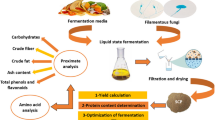Abstract
In present study thein vitro degradation of sugarcane bagasse and total mixed ration (i.e. sugarcane bagasse, wheat straw, and concentrate mixture in the ratio of 20∶30∶50) were tested using anaerobic rumen fungiNeocallimastix spp. GR1 andPiromyces spp. WNG-12. These cultures produced hydrolytic enzymes (CMCase, FPCase and xylanase)and increased thein vitro digestibility of dry matter, neutral detergent fibre, and acid detergent fibre of bagasse and total mixed rations when compared with control.Neocallimastix spp. GR1 andPiromyces spp. WNG-12 also increased total volatile fatty acids by degradation of sugarcane bagasse and total mixed ration. Based on results obtained, it may be stated thatNeocallimastix spp. GR1 may improve the nutritive value of high fibrous based diets.
Similar content being viewed by others
References
AOAC — Association of Official Analytical Chemists (2000). Official Methods of Analysis. International Volume I, 17th edn., Gaithersburg Maryland USA.
Barnett A.J.G., Reid R.L. (1957). Studies on production of volatile fatty acids from grass by rumen liquid in an artificial rumen. J. Agric. Sci. (Camb), 48: 315–321.
Dayananda T.L., Nagpal R., Puniya A.K., Sehgal J.P., Singh K. (2007).In-vitro degradation of urea-NH3 treated wheat straw using anaerobic ruminal fungi. J. Anim. Feed Sci., 16: 484–489.
Dey A., Sehgal J.P., Puniya A.K., Singh K. (2004). Influence of an anaerobic fungal culture (Orpinomyces spp.) administration on growth rate ruminal fermentation and nutrient digestion in calves. Asian-Aust. J. Anim. Sci., 17: 820–824.
Edwards J.E., Kingston-Smith A.H., Jimenez H.R., Huws S.A., Skot K.P., Griffith G.W., McEwan N.R., Theodorou M.K. (2008). Dynamics of initial colonization of nonconserved perennial ryegrass by anaerobic fungi in the bovine rumen. FEMS Microbiol. Ecol., 66 (3): 537–545.
Goering H.K., VanSoest P.J. (1970). Forage Fibre Analysis Agricultural Handbook No. 379, USDA, Washington DC.
Ha J.K., Lee S.S., Kim C.H., Choi Y.J., Min H.K. (1994). Effect of fungal inoculation on ruminal fermentation characteristics enzyme activities and nutrient-digestion in sheep. Proc. Soc. Nutr. Physiol., 3: 197.
Joblin K.N. (1981). Isolation enumeration and maintenance of rumen anaerobic fungi in roll tubes. Appl. Environ. Microbiol., 42: 1119–1122.
Kawaminami T., Izuka H. (1970). Studies on xylanase from microorganisms. IV. Action of xylanase ofChaetomium trilaterate strain No. 2264 upon xylan. J. Ferment. Technol., 48: 161–168.
Lee S.S., Ha J.K., Cheng K.J. (2000). Influence of an anaerobic fungal culture administration onin vivo ruminal fermentation and nutrient digestion. Anim. Feed Sci. Technol., 88: 201–217.
Mandels M., Andreotti R., Roche C. (1976).Measurement of sac-charifying cellulase. Biotechnol. Bioeng. Symp., 6: 21–23.
Manikumar B., Puniya A.K., Singh K., Sehgal J.P. (2004).In vitro degradation of cell wall and digestibility of cereal straws treated with anaerobic ruminal fungi. Indian J. Exp. Biol., 42: 636–638.
McAllister T.A., Bae H.D., Yanke L.J., Cheng K.J., Muir A. (1994). Effect of condensed tannins from birdsfoot trefoil on endoglucanase activity and the digestion of cellulose filter paper by ruminal fungi. Can. J. Microbiol., 40: 298–305.
McDougall E.I. (1948). Studies on ruminant saliva. I. The composition and output of sheeps’ saliva. Biochem. J., 43: 99–109.
Miller G.L. (1959). Use of dinitrosalicylic acid reagent for determination of reducing sugars. Anal Chem., 31: 426.
Paul S.S., Kamra D.N., Sastry V.R.B., Agarwal N. (2004). Effect of administration of an anaerobic gut fungus isolated from wild blue bull to buffaloes onin-vivo ruminal fermentation and digestion of nutrients. Anim. Feed Sci. Tech., 115: 143–157.
Reddy G.V.N., Reddy K.J., Nagalakshmi D. (2002). Effect of expander-extruder processed complete diet containing sugarcane bagasse on growth and nutrient utilization in Ongole bull calves. Indian J. Anim. Sci., 72: 406–409.
Reddy M.R., Chandrasekharaiah M., Govindaiah T., Reddy G.V.N. (1993). Effect of physical processing on the nutritive value of sugarcane bagasse in goat and sheep. Small Ruminant Res., 10: 25–30.
Robertson J.B., VanSoest P.J. (1977). Dietary fibre estimation in concentrate feedstuffs. J. Anim. Sci., 45: 254.
Sehgal J.P., Jit D., Puniya A.K., Singh K. (2008). Influence of anaerobic fungal administration on growth, rumen fermentation and nutrient digestion in female buffalo calves. J. Anim. Feed Sci., 17: 510–518.
Snedecor G.W., Cochran W.G. (1980). Statistical Methods 7th edn., The Iowa State University Press, Iowa USA.
Srinivasan K., Murakami M., Nakashimada Y., Nishio N. (2001). Efficient production of cellulolytic and xylanolytic enzymes by the rumen anaerobic fungus,Neocallimastix frontalis in a repeated batch culture. J. Biosci. Bioeng., 91: 153–158.
Thareja A., Puniya A.K., Goel G., Nagpal R., Sehgal J.P., Singh P., Singh K. (2006).In vitro degradation of wheat straw by anaerobic fungi from small ruminants. Arch. Anim. Nutr., 60: 412–417.
Tilley J.M.A., Terry R.A. (1963). A two stage technique for thein vitro digestion of forage crops. J. British Grass. Soc., 18: 104–111.
Trinci A.P.J., Davies D.R., Gull K., Lawrence M.I., Nielsen B.B., Rickers A., Theodorou M.K. (1994). Anaerobic fungi in herbivorous animals. Mycol. Res., 98: 129–152.
Tripathi V.K., Sehgal J.P., Puniya A.K., Kishan S. (2007a). Hydrolytic activities of anaerobic fungi isolated from wild blue bull (Boselaphus tragocamelus). Anaerobe, 13: 36–39.
Tripathi V.K., Sehgal J.P., Puniya A.K., Singh K. (2007b). Effect of administration of anaerobic fungi isolated from cattle and wild blue bull (Boselaphus tragocamelus) on growth rate and fibre utilization in buffalo calves. Arch. Anim. Nutr., 61: 416–423.
Zadrazil F., Puniya A.K. (1995). Studies on effect of particle size during solid state fermentation of sugarcane bagasse into animal feed using white rot fungi. Bioresource Technol., 54: 85–87.
Author information
Authors and Affiliations
Corresponding author
Rights and permissions
About this article
Cite this article
Shelke, S.K., Chhabra, A., Puniya, A.K. et al. In vitro degradation of sugarcane bagasse based ruminant rations using anaerobic fungi. Ann. Microbiol. 59, 415–418 (2009). https://doi.org/10.1007/BF03175124
Received:
Accepted:
Issue Date:
DOI: https://doi.org/10.1007/BF03175124




